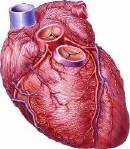 |
 |
 |

Limited Value Found for First-Generation Heart Pumps
But newer models are much more effective, expert says|
|
HealthDay
Tuesday, November 25, 2008
 TUESDAY, Nov. 25 (HealthDay News) -- The first generation of ventricular assist devices (VADs) -- tiny pumps implanted in people with failing hearts -- are costly but provide limited benefits, a study finds.
TUESDAY, Nov. 25 (HealthDay News) -- The first generation of ventricular assist devices (VADs) -- tiny pumps implanted in people with failing hearts -- are costly but provide limited benefits, a study finds.
However, the finding should not affect current medical practice, because the devices it describes are already being replaced by second- and third-generation VADS that are far superior, one expert said.
The study, published in the Journal of the American Medical Association, used data on almost 3,000 people who had VADs installed in a Medicare program between 2000 and 2006. Half the VADs were implanted as a primary treatment for heart failure, which is a progressive decline in the heart's ability to pump blood. The other half of the devices were implanted after a bypass surgery.
Fifty-five percent of those in the primary treatment group were discharged alive from the hospital, with 42 percent of dying over the following year, the researchers found. In the post-surgery group, a third were discharged alive from the hospital, and one quarter were alive a year later.
The total cost for patients in the primary treatment group was nearly $200,000 per person, the team estimated. The price tag was about $100,000 for those in the post-bypass group.
Given the cost and the uncertainty as to outcomes, "we need better data so we can have predictive tools in terms of understanding which patients will be successful and those who are extremely unlikely to live long with a VAD," said study lead author Dr. Adrian F. Hernandez, assistant professor of medicine at the Duke Cardiovascular Research Institute in Durham, N.C.
That data will come from a registry that is being kept of all the people who receive VADs, Hernandez said. Meanwhile, he said, "we certainly need more clinical studies to find out what is the right window for offering a patient a VAD."
The registry that now is being maintained will provide the needed information, said Dr. John V. Conte, director of the heart transplant and cardiovascular circulatory support program at Johns Hopkins University, but the findings of the new study can safely be disregarded, anyway, he said.
"The pump looked at in this study are not the pumps that primarily are used today," Conte said. "No second-generation pumps had yet been approved" at the time the study was conducted, he noted.
"This is a well-intentioned study, but in no way, shape or form should anyone make any conclusions based on this study," Conte contended.
First-generation VADs relied on a system of valves, subject to wear and tear, to control blood flow, he explained. "By 2003, we were starting to look at second-generation pumps that are smaller and more reliable. The ones available during this time period we know were not designed for long-term, many-year use," he said.
One second-generation VAD, which uses a rotating impeller to move blood, is now in general use, with more awaiting approval, Conte said. Third-generation pumps, which use electromagnetic impellers, have also made their appearance.
The latter "have no moving parts that can wear out," he said. "The second-generation pumps have bearings that can wear out."
And so a study of the first VADs to be implanted "is like talking about how the Model T works in today's environment," Conte said.
The study did make one valid point, he said. It found that results were best in hospitals that implanted many VADs and poorest in facilities implanting only one or two a year.
"Those people who do a large or moderate volume of procedures probably do a better job at it," Conte said. "We found a similar result in a study of heart transplants."
Information on the true value of VADs will start to emerge from the national registry, Conte said. "The patients we want to follow are those getting second- and third-generation pumps," he said. "Those are the ones we really need data on."
HealthDay
Copyright (c) 2008 ScoutNews, LLC. All rights reserved.
Related News:
- More News on Coronary Artery Bypass Surgery
- More News on Heart Failure
- More News on Medical Device Safety
More News on this Date
Related MedlinePlus Pages:
| Home | Health Topics | Drugs & Supplements | Encyclopedia | Dictionary | News | Directories | Other Resources | |
| Disclaimers | Copyright | Privacy | Accessibility | Quality Guidelines U.S. National Library of Medicine, 8600 Rockville Pike, Bethesda, MD 20894 National Institutes of Health | Department of Health & Human Services |
Date last updated: 26 November 2008 |




